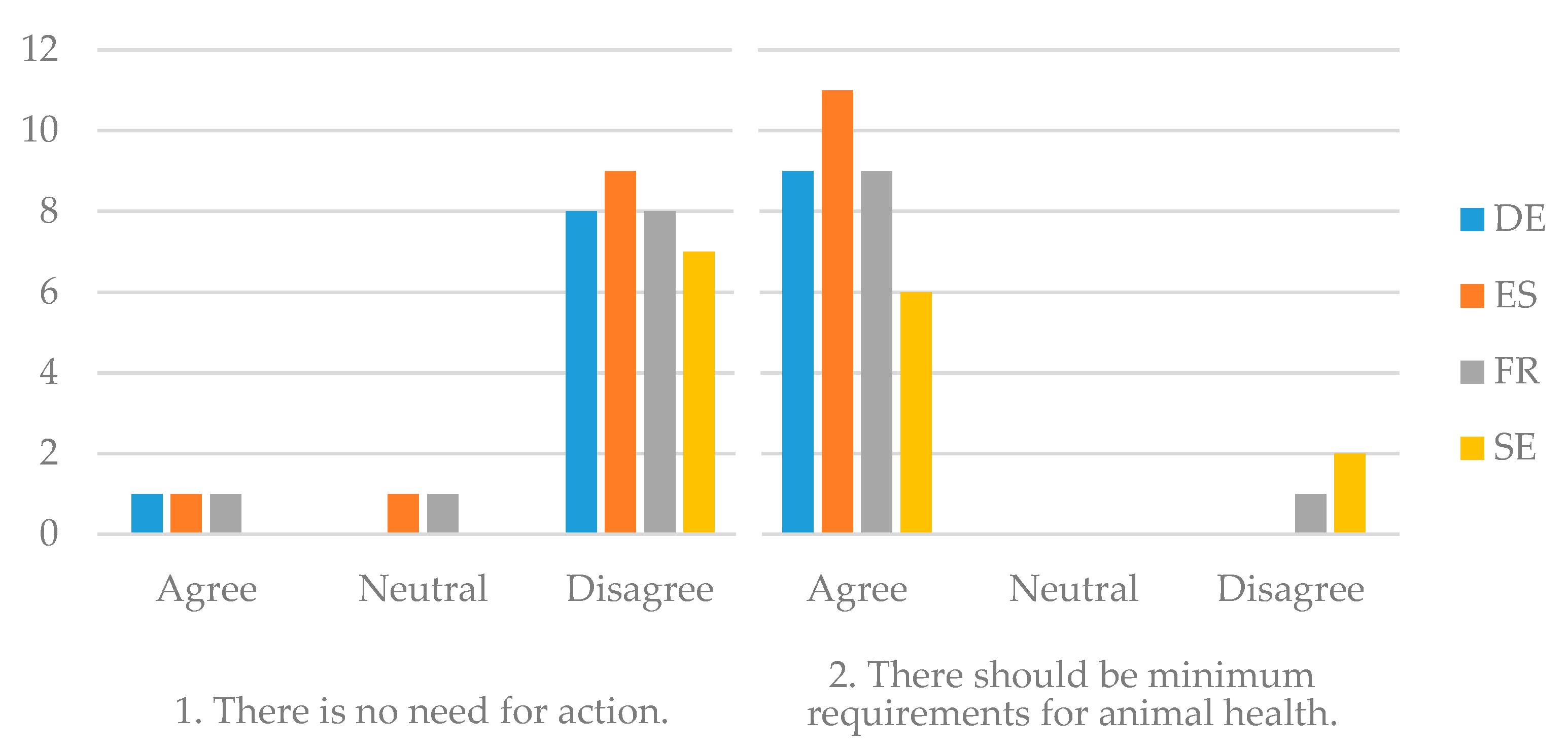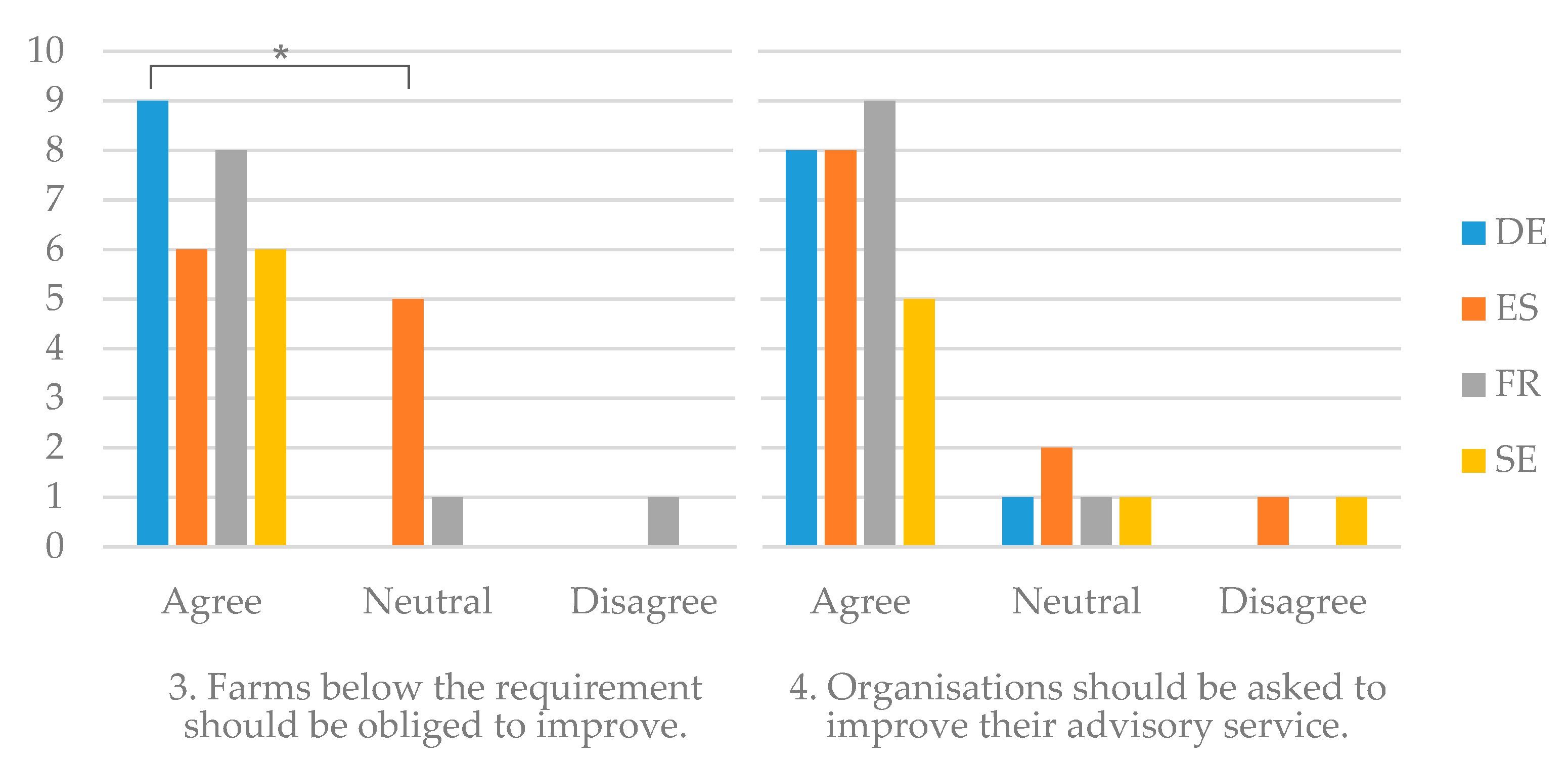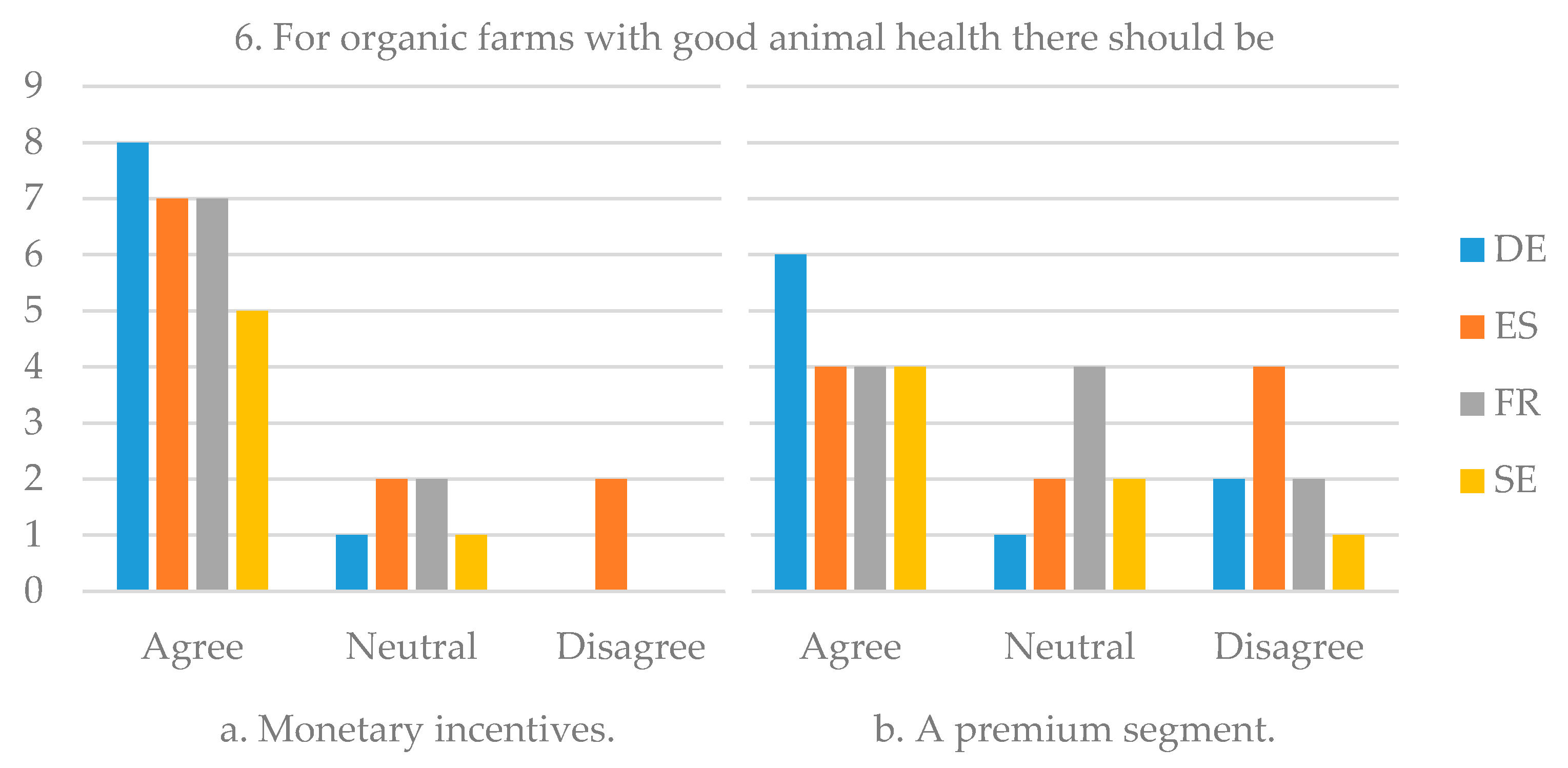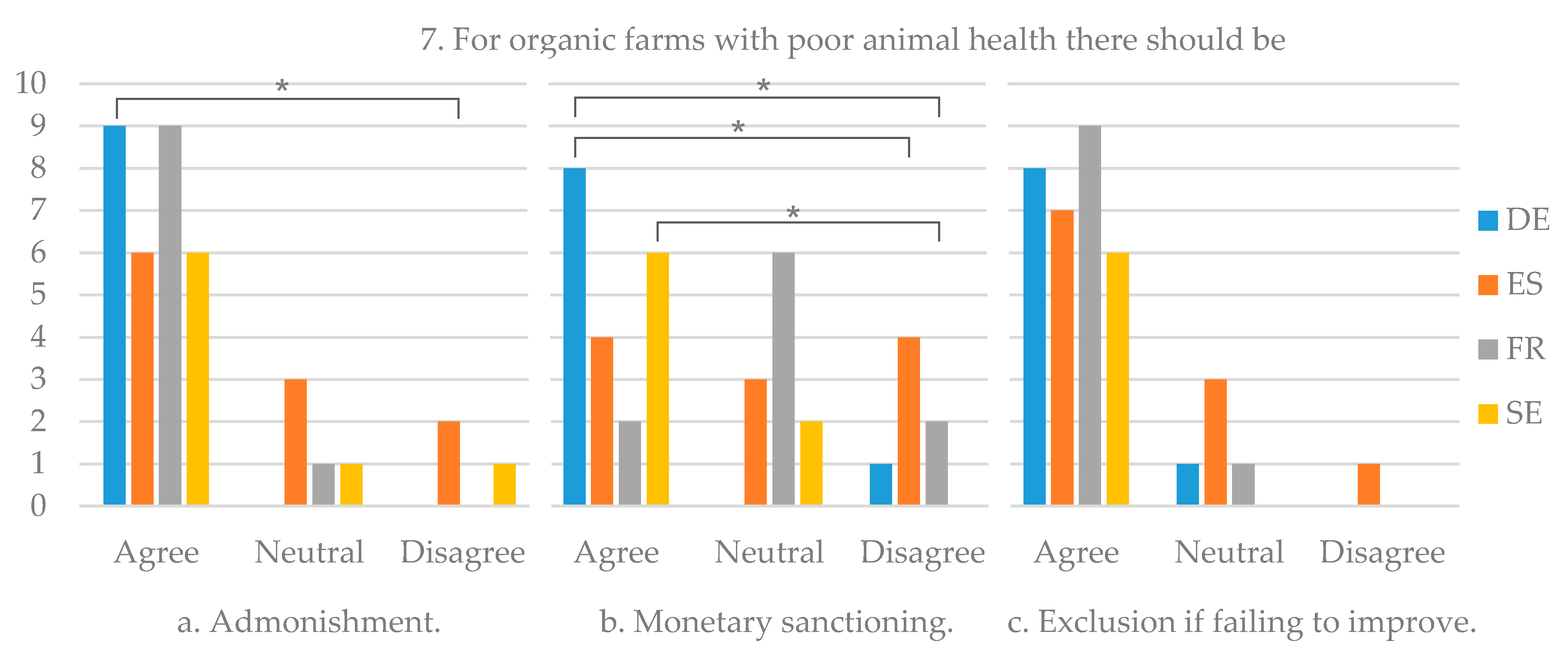Improving Animal Health on Organic Dairy Farms: Stakeholder Views on Policy Options
Abstract
1. Introduction
- What policy and market conditions would be required to (a) ensure the routine measurement of the current health status of organic dairy cattle, (b) set targets for outcome-oriented animal health indicators, and (c) ensure remedial actions to deal with performance failures?
- What policy options would lead farmers to achieve more aspirational animal health statuses?
2. Materials and Methods
2.1. Terminology
2.2. Data Collection
2.3. Data Editing and Analysis
2.4. Ethical Approval
3. Results and Discussion
3.1. Measuring Current Health Status
3.2. Minimum Health Status Requirements
3.3. Legislation and Market Differentiation
“The organic label does not guarantee the quality of the product, only that it is produced organically.”
“What would ‘premium organic’ say about ‘ordinary organic’? There is a risk of watering down the brand.” (Swedish stakeholder);
“Improving the already ‘good’ image of organic farms will only confuse the consumer, since it presupposes that there will be ‘less good’ organic farms which is inconsistent with the image that the consumer has in mind.” (Spanish stakeholder).
3.4. Policy Instruments
3.4.1. Legal Instruments: Disciplinary Sanctions
3.4.2. Financial Instruments: Monetary Sanctions and Incentives
“The improvement of health in organic farming should be primarily by positive reinforcement (incentives) and not by sanctions.”
“Sanctions are not the way to go. Poor management has a negative effect on animal health and farm profitability anyway. Thus, farms would be doubly punished.”
“There should be concrete financial aid [from government] to improve animal health.”
3.4.3. Communicative Instruments: Advisory Services
“Animal health is not achieved through inspection itself but through advisory and education. Having a common aim and creating awareness will lead to development and thus to improvement.”
“I am not a supporter of awards nor punishments for farms, but help is okay.”
3.5. Policy Implications
3.6. General Methodological Considerations
4. Conclusions
Author Contributions
Funding
Acknowledgments
Conflicts of Interest
References
- Eloit, M. The global public good concept: A means of promoting good veterinary governance. Rev. Off. Int. Epizoot. 2012, 31, 577–590. [Google Scholar] [CrossRef]
- Fraser, D. Understanding animal welfare. Acta Vet. Scand. 2008, 50 (Suppl. 1), S1–S12. [Google Scholar] [CrossRef]
- Broom, D.M. Behaviour and welfare in relation to pathology. Appl. Anim. Behav. Sci. 2006, 97, 73–83. [Google Scholar] [CrossRef]
- Broom, D.M. Animal welfare defined in terms of attempts to cope with the environment. Acta Agric. Scand. Sect. A Anim. Sci. Suppl. 1996, 27, 22–28. [Google Scholar]
- Nalon, E.; Stevenson, P. Protection of Dairy Cattle in the EU: State of Play and Directions for Policymaking from a Legal and Animal Advocacy Perspective. Animals 2019, 9, 1066. [Google Scholar] [CrossRef]
- Stevenson, P. Review of Animal Welfare Legislation in the Beef, Pork, and Poultry Industries; FAO: Rome, Italy, 2014; Available online: http://www.fao.org/3/a-i4002e.pdf (accessed on 8 April 2020).
- European Commission (EC). European Union Strategy for the Protection and Welfare of Animals 2012–2015; COM (2012), 6 final/2, EC. Brussels, Belgium, 2012. Available online: https://ec.europa.eu/food/sites/food/files/animals/docs/aw_eu_strategy_19012012_en.pdf (accessed on 25 March 2020).
- World Organisation for Animal Health (OIE). Animal Welfare at a Glance. Available online: www.oie.int/en/animal-welfare/animal-welfare-at-a-glance/ (accessed on 29 May 2019).
- International Federation of Organic Agriculture Movements (IFOAM). The IFOAM Norms for Organic Production and Processing; IFOAM-Organics International: Bonn, Germany, 2019; Available online: https://www.ifoam.bio/sites/default/files/ifoam_norms_july_2014_edits_2019.pdf (accessed on 25 March 2020).
- Harper, G.C.; Makatouni, A. Consumer perception of organic food production and farm animal welfare. Br. Food J. 2002, 104, 287–299. [Google Scholar] [CrossRef]
- McEachern, M.G.; Willock, J. Producers and consumers of organic meat. Br. Food J. 2004, 106, 534–552. [Google Scholar] [CrossRef]
- Council Regulation (EC) No 834/2007 of 28 June 2007 on Organic Production and Labelling of Organic Products and Repealing Regulation (EEC) No 2092/91; Official Journal of the European Union L 189/1; Luxembourg, 2007.
- Arcuri, A. The Transformation of organic regulation: The ambiguous effects of publicization. Regul. Gov. 2015, 9, 144–159. [Google Scholar] [CrossRef]
- Sutherland, M.A.; Webster, J.; Sutherland, I. Animal Health and Welfare Issues Facing Organic Production Systems. Animals 2013, 3, 1021–1035. [Google Scholar] [CrossRef]
- EUROSTAT. Organic Farming Survey. Available online: http://appsso.eurostat.ec.europa.eu/nui/show.do?dataset=org_coptyp (accessed on 4 June 2019).
- Best, H. Organic agriculture and the conventionalization hypothesis: A case study from West Germany. Agric. Hum. Values 2008, 25, 95–106. [Google Scholar] [CrossRef]
- Stolze, M.; Lampkin, N. Policy for organic farming: Rationale and concepts. Food Policy 2009, 34, 237–244. [Google Scholar] [CrossRef]
- Schmid, O.; Dabbert, S.; Eichert, C.; Gonzalvez, V.; Lampkin, N.; Michelsen, J.; Slabe, A.; Stokkers, R.; Stolze, M.; Stopes, C. (Eds.) Organic Action Plans. Development, Implementation and Evaluation; A Resource Manual for the Organic Food and Farming Sector; FiBL: Frick, Switzerland, 2008; ISBN 978-3-03736-022-4. [Google Scholar]
- EFSA. Statement on the use of animal-based measures to assess the welfare of animals. EFSA J. 2012, 10, 344. [Google Scholar] [CrossRef]
- Häring, A.M.; Vairo, D.; Dabbert, S.; Zanoli, R. Organic farming policy development in the EU: What can multi-stakeholder processes contribute? Food Policy 2009, 34, 265–272. [Google Scholar] [CrossRef]
- Morgan, D.L. Focus Groups. Annu. Rev. Sociol. 1996, 22, 129–152. [Google Scholar] [CrossRef]
- Van Soest, F.J.S.; Mourits, M.C.M.; Hogeveen, H. European organic dairy farmers’ preference for animal health management within the farm management system. Animal 2015, 9, 1875–1883. [Google Scholar] [CrossRef] [PubMed]
- Krieger, M.; Sjöström, K.; Blanco-Penedo, I.; Madouasse, A.; Duval, J.E.; Bareille, N.; Fourichon, C.; Sundrum, A.; Emanuelson, U. Prevalence of production disease related indicators in organic dairy herds in four European countries. Livest. Sci. 2017, 198, 104–108. [Google Scholar] [CrossRef]
- R Core Team. R: A Language and Environment for Statistical Computing; R Foundation for Statistical Computing: Vienna, Austria, 2017; Available online: https://www.R-project.org/ (accessed on 4 June 2019).
- Von Borell, E.; Sørensen, J.T. Organic livestock production in Europe: Aims, rules and trends with special emphasis on animal health and welfare. Livest. Prod. Sci. 2004, 90, 3–9. [Google Scholar] [CrossRef]
- Sundrum, A. Organic Livestock Production. In Encyclopedia of Agriculture and Food Systems; van Alfen, N.K., Ed.; Academic Press: Oxford, UK, 2014; pp. 287–303. ISBN 978-0-08-093139-5. [Google Scholar]
- Darnhofer, I.; Lindenthal, T.; Bartel-Kratochvil, R.; Zollitsch, W. Conventionalisation of organic farming practices: From structural criteria towards an assessment based on organic principles. A review. Agron. Sustain. Dev. 2010, 30, 67–81. [Google Scholar] [CrossRef]
- Miele, M.; Lever, J. Improving animal welfare in Europe. In Sustainable Food Systems: Building a New Paradigm; Marsden, T., Morley, A., Eds.; Routledge: London, UK, 2014; pp. 143–165. ISBN 0415639557. [Google Scholar]
- Brinkmann, J.; March, S. Tiergesundheit [Animal health]. In Faustzahlen für den Ökologischen Landbau [Reference Values for Organic Farming]; KTBL, Ed.: Darmstadt, Germany, 2015; pp. 472–477. ISBN 3945088054. [Google Scholar]
- Brinkmann, J.; March, S.; Renziehausen, C.; Bergschmidt, A. Indicators for a result-oriented approach for animal welfare policies and organic farming. In Proceedings of the 6th International Conference on the Assessment of Anim. Welfare at Farm and Group Level, WAFL 2014, Clermont-Ferrand, France, 3–5 September 2014; Mounier, L., Veissier, I., Eds.; Wageningen Academic Publishers: Wageningen, The Netherlands, 2014; p. 88. [Google Scholar]
- Werner, C.; Löser, R.; Kempkens, K.; Sundrum, A. Leitlinien zur Sicherung der Tiergesundheit in der ökologischen Schweineerzeugung [Guidelines to secure animal health in organic pig production]. Landbauforschung Völkenrode Sonderheft 2008, 320, 99–108. [Google Scholar]
- Sumner, C.L.; von Keyserlingk, M.A.G.; Weary, D.M. Perspectives of farmers and veterinarians concerning dairy cattle welfare. Anim. Front. 2018, 8, 8–13. [Google Scholar] [CrossRef]
- Växa Sverige. Signaler Djurvälfärd. Available online: https://www.vxa.se/radgivning-och-kurser/analysera-nulaget/analysera-djurhalsan/signaler-djurvalfard/ (accessed on 29 May 2019).
- March, S.; Bergschmidt, A.; Renziehausen, C.; Brinkmann, J. Indicators for a Payment-by-Results Approach for Animal Welfare Measures and Organic Farming; Final Report; BÖLN Project, 11NA026, Thünen Institute: Braunschweig, Germany, 2017. [Google Scholar]
- Ingenbleek, P.T.M.; Harvey, D.; Ilieski, V.; Immink, V.M.; de Roest, K.; Schmid, O. The European Market for Animal-Friendly Products in a Societal Context. Animals 2013, 3, 808–829. [Google Scholar] [CrossRef] [PubMed]
- Von Meyer-Höfer, M.; Nitzko, S.; Spiller, A. Is there an expectation gap? Consumers’ expectations towards organic. Br. Food J. 2015, 117, 1527–1546. [Google Scholar] [CrossRef]
- Buller, H.; Roe, E. Commodifying animal welfare. Anim. Welf. 2012, 21, 131–135. [Google Scholar] [CrossRef]
- Kjærnes, U.; Harvey, M.; Warde, A. Trust in Food. A Comparative and Institutional Analysis; Palgrave Macmillan: Basingstoke, UK, 2007; ISBN 9780230627611. [Google Scholar]
- Żakowska-Biemans, S.; Tekień, A. Free Range, Organic? Polish Consumers Preferences Regarding Information on Farming System and Nutritional Enhancement of Eggs: A Discrete Choice Based Experiment. Sustainability 2017, 9, 1999. [Google Scholar] [CrossRef]
- Dabbert, S.; Lippert, C.; Schulz, T.; Zorn, A. CERTCOST—Economic analysis of certification systems for organic food and farming at EU level. In Cultivating the Future Based on Science, Proceedings of the Second Scientific Conference of the International Society of Organic Agriculture Research (ISOFAR), held at the 16th IFOAM Organic World Congress in Cooperation with the International Federation of Organic Agriculture Movements (IFOAM) and the Consorzio ModenaBio, Modena, Italy, 18–20 June 2008; Neuhoff, D., Halberg, T., Alföldi, N., Lockeretz, W., Thommen, A., Rasmussen, I.A., Hermansen, J., Vaarst, M., Lueck, L., Caporali, F., et al., Eds.; International Society of Organic Agriculture Research (ISOFAR), c/o IOL: Bonn, Germany; Research Institute of Organic Agriculture FiBL: Frick, Switzerland, 2008; pp. 390–393. [Google Scholar]
- Van Bueren, E.M.; Lammerts van Bueren, E.T.; van der Zijpp, A.J. Understanding wicked problems and organized irresponsibility: Challenges for governing the sustainable intensification of chicken meat production. Curr. Opin. Environ. Sustain. 2014, 8, 1–14. [Google Scholar] [CrossRef]
- Henson, S.; Reardon, T. Private agri-food standards: Implications for food policy and the agri-food system. Food Policy 2005, 30, 241–253. [Google Scholar] [CrossRef]
- Vogeler, C.S. Market-Based Governance in Farm Animal Welfare-A Comparative Analysis of Public and Private Policies in Germany and France. Animals 2019, 9, 267. [Google Scholar] [CrossRef]
- European Commission (EC). Special Eurobarometer 442: Attitudes of Europeans towards Animal Welfare. Available online: http://data.europa.eu/euodp/data/dataset/S2096_84_4_442_ENG (accessed on 31 March 2020).
- Lundmark, F.; Berg, C.; Schmid, O.; Behdadi, D.; Röcklinsberg, H. Intentions and values in animal welfare legislation and standards. J. Agric. Environ. Ethics 2014, 27, 991–1017. [Google Scholar] [CrossRef]
- Weary, D.M.; von Keyserlingk, M.A.G. Public concerns about dairy-cow welfare: How should the industry respond? Anim. Prod. Sci. 2017, 57, 1201. [Google Scholar] [CrossRef]
- KRAV. Standards for KRAV-Certified Production, 2019–20 ed.; The KRAV Association: Uppsala, Sweden, 2018. [Google Scholar]
- Ingenbleek, P.T.M.; Immink, V.M.; Spoolder, H.A.M.; Bokma, M.H.; Keeling, L.J. EU animal welfare policy: Developing a comprehensive policy framework. Food Policy 2012, 37, 690–699. [Google Scholar] [CrossRef]
- Van Soest, F.J.S.; Mourits, M.C.M.; Blanco-Penedo, I.; Duval, J.; Fall, N.; Krieger, M.; Sjöstrom, K.; Hogeveen, H. Farm-specific failure costs of production disorders in European organic dairy herds. Prev. Vet. Med. 2019, 168, 19–29. [Google Scholar] [CrossRef] [PubMed]
- Huijps, K.; Hogeveen, H.; Lam, T.J.G.M.; Oude Lansink, A.G.J.M. Costs and efficacy of management measures to improve udder health on Dutch dairy farms. J. Dairy Sci. 2010, 93, 115–124. [Google Scholar] [CrossRef]
- Hogeveen, H.; Huijps, K.; Lam, T.J.G.M. Economic aspects of mastitis: New developments. N. Z. Vet. J. 2011, 59, 16–23. [Google Scholar] [CrossRef] [PubMed]
- Sjöström, K.; Sternberg-Lewerin, S.; Blanco-Penedo, I.; Duval, J.E.; Krieger, M.; Emanuelson, U.; Fall, N. Effects of a participatory approach, with systematic impact matrix analysis in herd health planning in organic dairy cattle herds. Animal 2019, 13, 358–366. [Google Scholar] [CrossRef] [PubMed]
- Duval, J.E.; Bareille, N.; Fourichon, C.; Madouasse, A.; Vaarst, M. How can veterinarians be interesting partners for organic dairy farmers? French farmers’ point of views. Prev. Vet. Med. 2017, 146, 16–26. [Google Scholar] [CrossRef]
- Eshuis, J.; Stuiver, M. Learning in context through conflict and alignment: Farmers and scientists in search of sustainable agriculture. Agric. Hum. Values 2005, 22, 137–148. [Google Scholar] [CrossRef]
- Hulsen, J. Cow Signals. A Practical Guide for Dairy Farm Management, UK/Ireland ed.; Roodbont: Zutphen, The Netherlands, 2012; ISBN 9789075280654. [Google Scholar]
- Anneberg, I.; Vaarst, M.; Sandøe, P. To inspect, to motivate or to do both: A dilemma for on-farm inspection of animal welfare. In Proceedings of the 6th International Conference on the Assessment of Animal Welfare at Farm and Group Level, WAFL 2014, Clermont-Ferrand, France, 3–5 September 2014; Mounier, L., Veissier, I., Eds.; Wageningen Academic Publishers: Wageningen, The Netherlands, 2014; p. 73. [Google Scholar]
- McInerney, J. Animal Welfare, Economics and Policy; Farm & Animal Health Economics Division of Defra: London, UK, 2004. [Google Scholar]
- Bekhet, A.K.; Zauszniewski, J.A. Methodological triangulation: An approach to understanding data. Nurse Res. 2012, 20, 40–43. [Google Scholar] [CrossRef]





| France | Germany | Spain | Sweden | |
|---|---|---|---|---|
| Farmers | 1 | 1 a | 2 a | 2 a |
| Advisors | 2 | 5 b | 1 b | 3 b |
| Veterinarians | 2 | 1 b | 2 b | 3 b |
| Inspectors | - | 1 | - | 1 |
| Processors | - | 1 a | - | 2 a |
| Retailers | - | - | 2 a | 1 |
| Researchers | 5 | 1 | 5 | - |
| Others 1 | - | 1 | 2 | - |
| Total 2 | 10 | 9 | 11 | 9 |
© 2020 by the authors. Licensee MDPI, Basel, Switzerland. This article is an open access article distributed under the terms and conditions of the Creative Commons Attribution (CC BY) license (http://creativecommons.org/licenses/by/4.0/).
Share and Cite
Krieger, M.; Jones, P.J.; Blanco-Penedo, I.; Duval, J.E.; Emanuelson, U.; Hoischen-Taubner, S.; Sjöström, K.; Sundrum, A. Improving Animal Health on Organic Dairy Farms: Stakeholder Views on Policy Options. Sustainability 2020, 12, 3001. https://doi.org/10.3390/su12073001
Krieger M, Jones PJ, Blanco-Penedo I, Duval JE, Emanuelson U, Hoischen-Taubner S, Sjöström K, Sundrum A. Improving Animal Health on Organic Dairy Farms: Stakeholder Views on Policy Options. Sustainability. 2020; 12(7):3001. https://doi.org/10.3390/su12073001
Chicago/Turabian StyleKrieger, Margret, Philip J. Jones, Isabel Blanco-Penedo, Julie E. Duval, Ulf Emanuelson, Susanne Hoischen-Taubner, Karin Sjöström, and Albert Sundrum. 2020. "Improving Animal Health on Organic Dairy Farms: Stakeholder Views on Policy Options" Sustainability 12, no. 7: 3001. https://doi.org/10.3390/su12073001
APA StyleKrieger, M., Jones, P. J., Blanco-Penedo, I., Duval, J. E., Emanuelson, U., Hoischen-Taubner, S., Sjöström, K., & Sundrum, A. (2020). Improving Animal Health on Organic Dairy Farms: Stakeholder Views on Policy Options. Sustainability, 12(7), 3001. https://doi.org/10.3390/su12073001






